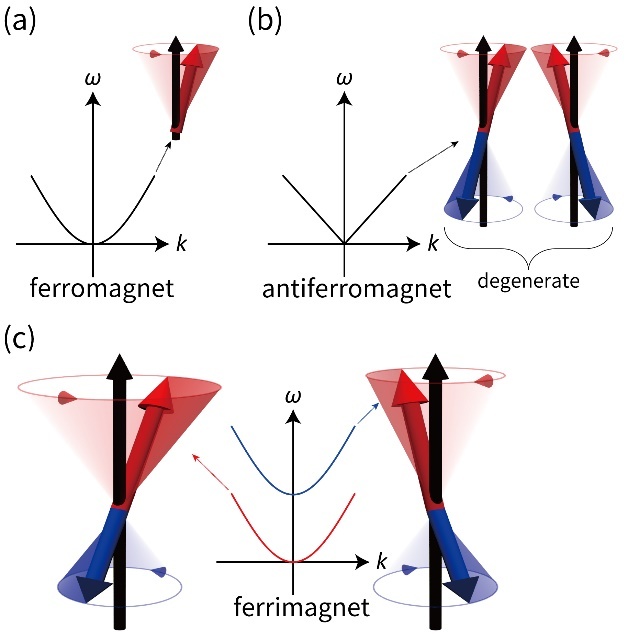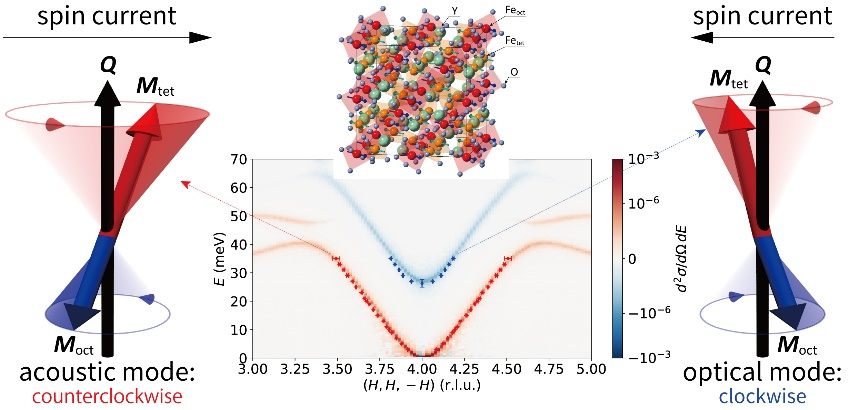Topics
2020.2.3
Polarized neutrons can observe propagation mechanism of the spin current
Condensed spin matter group
We here introduce a research performed in Condensed Spin Matter Group.
We, Spin Condensed Matter Group, carry out research projects which focus on quantum phenomena related to electronic spins in hard condensed matter, using quantum beam techniques such as X-ray, neutron, and muon. Neutron scattering is known as a very powerful microscopic measurement tool among the quantum beams. Scattered neutrons from nuclei and unpaired electron spins, can respectively provide information on the crystal structure and magnetism. These scattering processes can be understood by the linear response theory; hence the quantitative discussion of the measured intensity is also possible. These lead to a widespread application to almost all sorts of condensed matter from hard to soft matter. Here we introduce the application of polarized neutron scattering technique to spintronics, which utilizes the neutrons’ spin degree of freedom.
In magnets, spin waves, the elementary excitations of magnetic order, are quantized into “magnons,” bosons carrying energy, linear momentum, and spin angular momentum. The Landau-Lifshitz-Gilbert equation that describes the motion of the magnetic moment, depicts a magnetic moment precessing counterclockwise around the quantized axis. We define this motion to be “positively” polarized. The magnetic order in simple ferromagnets also precesses only counterclockwise; therefore, all ferromagnetic magnons have a positive polarization (Fig. 1 (a)). Simple antiferromagnets have two magnon modes possessing the opposite polarization (Fig. 1 (b)), but these are degenerate unless large magnetic fields are applied, leading to a difficulty in observing them. Simple ferrimagnets have two oppositely aligned moments and also carry two magnon polarizations, but the sublattice moment and the exchange interaction naturally separate the branches of opposite polarization into acoustic and optical modes (Fig. 1 (c)). Since the energy gap between these modes can be moderately large, spectroscopic studies have the potential to observe this polarization. A direct experimental proof of the opposite polarization of the magnons is, however, missing so far. In ordered magnets, the spin current can be carried only by the transverse component of the precessional motion of the magnetic moment. Given that the magnon polarization mathematically corresponds to this transverse component, information on the sign and the quantitative elucidation are necessary for understanding the microscopic mechanism of the spin current.
We have observed the magnon polarization from the garnet Y3Fe5O12 (YIG) [1]. YIG is a ferrimagnetic insulator with a complex crystal structure (Fig. 2) and is a quintessential magnet for microwave and optical technologies and fundamental research in spintronics, magnonics, and quantum information. To detect the magnon polarization, neutron spins shall be aligned parallel or antiparallel to the scattering wave vector (Q). Magnetic neutron scattering can only detect the spin components perpendicular to Q, and these projections are tiny due to an application of the magnetic field (// Q). The component detected by this configuration corresponds to the area that the precessional motion covers, and the use of polarized neutrons can distinguish clockwise and counterclockwise motion through the chiral term detection. Figure 2 shows the observed neutron scattering spectra. Together with theoretical calculations, magnon polarization for both signs is clearly observed. The magnon precessional motion at the uniform Q is also schematically illustrated in Fig. 2.
We have thus introduced the first observation of the magnon polarization in the collinear ferrimagnet. Since the observed magnon polarization is directly related to the propagation direction of the spin current as mentioned above, it is important to figure out its microscopic mechanism in spintronics. We will further plan to apply this new experimental method to various magnetic materials to explore quantum phenomena that involve the magnon polarization.
[1] Y. Nambu et al., Phys. Rev. Lett. 125, 027201 (2020). Editors’ Suggestion



